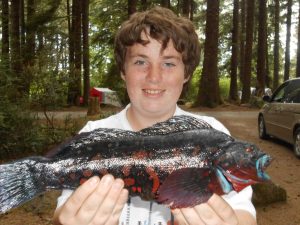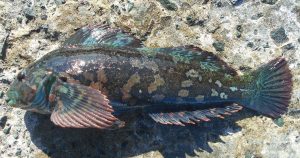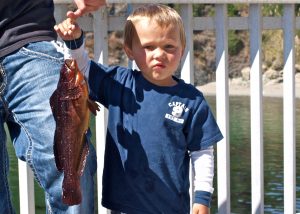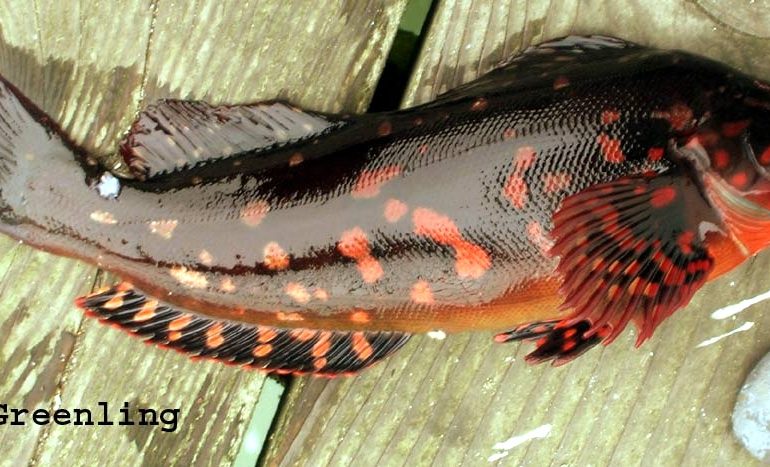Greenlings and Lingcod: Family Hexagrammidae
Species: Hexagrammos lagocephalus (Pallas, 1810); from the Greek words hex (six), gramma (line), lagos (hare) and cephelos (head, referring to the large pair of cirri on the head, attached to the edge of the eye).
Alternate Names: Commonly called seatrout but also red greenling, red seatrout, red rock trout, kelp cod and fringed greenling. The 19th century Portuguese fishermen of Monterey called these boregat.
Identification: Five lateral lines on the side, and one pair of cirri on the head. Their coloring is reddish-brown with darker mottling; they often have large, bright red spots and blotches. The inside of the mouth is blue.

Size: To 24 inches; most caught off piers are less than 15 inches. THE IGFA World Record fish weighed 5 Lbs 14 oz and was caught at Shiretoko, Japan in 2018.
Range: From Point Conception to Attu Island, Commander-Aleutian Chain Alaska, and northern Bering Sea. Also the Kurile Islands, Russia to the Okhotsk Sea (between Russia and Japan), Sea of Japan, and Yellow Sea (between Korea and China). Rarely encountered south of San Francisco.
Habitat: Usually found in inter-tidal and shallow-water rocky areas. Both juveniles and adults consume a wide variety of bethnic species; favorites include crabs, shrimp, snails, chiton, abalones, octopi, fish eggs, algae, and fish. A territorial species similar to kelp greenling.

Strangly-colored rock greenling from the Humbolt Bay jetty
Piers: Rock greenling are commonly taken from piers north of San Francisco, piers located near rocky areas. Best bets: Point Arena Pier, Trinidad Pier, and Citizens Dock (Crescent City).
Shoreline: A common catch for rocky shore anglers in northern California
Boats: Primarily an inshore fish so an uncommon catch for boaters. However, those boaters fishing in fairly shallow waters from San Francisco north catch a few.
Bait and Tackle: High/low leaders using size 6 hooks and baited with small pieces of shrimp, fresh mussels, pile worms or tube worms are the best set-up. Like kelp greenling, rock greenling will often tap the bait first and then return for a solid hit so be prepared.

Food Value: Greenling are good quality, mild-flavored fish with large flakes and moderate fat content. They’re suitable for most forms of cooking but they are especially good for pan frying. Most pier caught fish are fairly small so the fillets may not offer much meat.
Comments: About 50% of rock greenling are sexually mature at 3-4 years in age and 11.4-13.8 inches in length. Both kelp greenling and rock greenling make excellent bait for lingcod.
Also—some books use Hexagrammos superciliosus as the scientific name for this fish. I’m thinking we need a greenling with the name Hexagrammos supercalifragilisticexpialidocious. Perhap it would have some sort of a Mary Poppins look to it?

I’m curious about the rock greenling. Is it edible? If so, how is it prepared?
Greenlings are high-quality fish with a modest fat level, big flakes, and a mild flavor.
I like how your posts are full of useful information
Great website. Plenty of helpful info here. I’m sending it to some pals and additionally sharing in delicious. And of course, thank you in your effort!
The ideal setup involves high/low leads utilizing size 6 hooks and baited with tiny shrimp, fresh mussels, pile worms, or tube worms.
It’s also currently only accessible on Apple Arcade, but 1) Apple Arcade is a fantastic service for families, and 2) Apple Arcade exclusives usually make their way to other platforms
This is such a well-crafted and engaging piece.
With the Sprunki Phase 3 feature, players can dive into a colorful world where they mix sounds and beats to craft unique musical tracks.